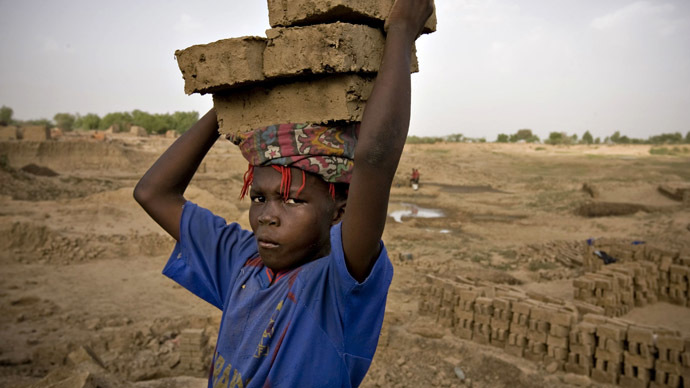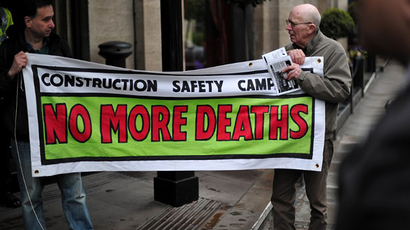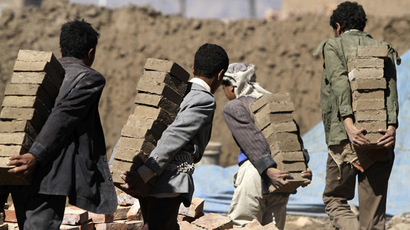Modern-day slavery a $150bn-a-year business – UN report

Nearly 21 million people are working as modern day slaves, falling victim to trafficking, forced labor and sexual exploitation, a new UN report finds. The illicit market in exploited people generates billions of dollars in profit worldwide.
The report by the International Labour Organization (ILO), which draws on information gathered in a 2012 survey, also found that annual profits stemming from forced labor are three times higher than previous estimates.
“Put into perspective, the 21 million victims in forced labor and the more than US$150 billion in illegal profits generated by their work exceeds the population and GDP of many countries or territories around the world,” the ILO says.
“Yet this vast nation of men, women and children, along with its resources, remains virtually invisible, hidden behind a wall of coercion, threats and economic exploitation.”
The investigators define forced labor as those practices “such as slavery and those similar to slavery - debt bondage and serfdom - as defined in other international instruments.” The ILO further says “trafficking in persons for the purpose of labor and sexual exploitation” qualify as forced labor.
Of the estimated 20.9 million people involved in forced labor worldwide, 18.7 million (90 percent) are exploited in the private economy by individuals or enterprises. The remaining 2.2 million (10 percent) are in state-imposed forms of forced labor, such as prisons, or in work imposed by military or paramilitary forces.
Approximately 14.2 million (68 percent) are victims of forced labor exploitation, primarily in agriculture, construction, domestic work, manufacturing, mining and utilities. Some 4.5 million (22 percent) are victims of forced sexual exploitation, with women and girls accounting for 11.4 million (55 percent) of those exploited.
According to the report, sexual exploitation offers the greater profit-per-victim ratio, due to the high market demands versus the low capital investments and operating costs.
“With a global average profit of US$21,800 per year per victim, this sector is six times more profitable than all other forms of forced labor, and five times more profitable than forced labor exploitation outside domestic work,” the report says.
According to the ILO, the sector accounts for around $99-billion in global profits annually –nearly double the amount generated by other forms of forced labor exploitation.

Another $51 billion is generated through domestic work, agriculture and “other economic activities.” Construction manufacturing, mining and utilities account for $34 billion in profits. Another $9 billion came from agriculture, with the remaining $8 billion stemming from unpaid or underpaid domestic workers in private residences.
The Asia-Pacific region by far is the largest hotbed for exploited laborers, accounting for 11.7 million (56 percent of the global total). Africa comes in at number two, accounting for 3.7 million (18 percent), while another 1.8 million (9 percent) of exploited laborers are in Latin America and the Caribbean.
The Developed Economies and European Union account for 1.5 million (7 percent), while countries of Central, South-Eastern and Eastern Europe (CSEE) and the Commonwealth of Independent States (CIS) have 1.6 million (7 percent).
An estimated 600,000 exploited workers, meanwhile, are believed to be in the Middle East.

ILO Director Guy Ryder said his agency's report calls attention to the need "to eradicate this fundamentally evil, but hugely profitable practice as soon as possible."
With poorer and less-educated people more vulnerable to exploitation, Ryder said his agency "for the first time provides solid evidence for a correlation between forced labor and poverty" by taking a look at both the supply and demand for workers.
"This new report takes our understanding of trafficking, forced labor and modern slavery to a new level," said Ryder. "Forced labor is bad for business and development and especially for its victims. Our new report adds new urgency to our efforts to eradicate this fundamentally evil, but hugely profitable practice as soon as possible."
Ryder recommends strengthening social protections to prevent households from becoming impoverished via sudden income shocks and debt bondage, thereby pushing people into forced labor.
"We need to improve levels of education and literacy so that household decision-makers can understand their own vulnerability to forced labor and know their rights as workers,” he continued.
The ILO also called on governments to strengthen laws and ratchet up enforcement measures to prevent human exploitation. It further called on multinationals to take the initiative and stamp out forced labor in their supply chains.
The report also says that good migration governance and a better understanding of the socio-economic root causes which lead to such forms of bondage would help eradicate a practice which “has no place in modern society.”














